Ubud is often regarded as the spiritual, artistic, and cultural heart of Bali. The best time to visit Bali is during the dry season, from April to October, when the weather is ideal for outdoor activities and sightseeing.
Ubud is alive during the dry season, with the colours and sounds of lively markets, where local artisans showcase their crafts, and the air is filled with the enticing aromas of Indonesian cuisine.
Just a stone’s throw away from the town, nature unfolds its astonishing beauty with green rice terraces that flow down the hills and beautiful waterfalls that add calm to the area. Historic temples filled with history and spirituality welcome visitors to explore their peaceful grounds.
For every kind of traveller, Ubud offers a myriad of experiences. Historic palaces with detailed carvings show the island’s rich heritage. Artist studios let visitors see how local talents create their works.
You can use your bargaining skills to find unique souvenirs. You can relax in a beautiful jungle club surrounded by nature or try exciting adventure activities that will get your heart racing. Ubud offers a lot to see and do, making it a great place for culture, relaxation, and adventure all in one spot.
Explore Puri Saren Agung (Ubud Royal Palace)
Puri Saren Agung, The Royal Palace of Ubud is a reflection of the Balinese architecture and design and was home to the royal family of Ubud. It is located in the city’s heart, and a little exploration is a sure thing to do in Ubud as you gain insights into royal history.
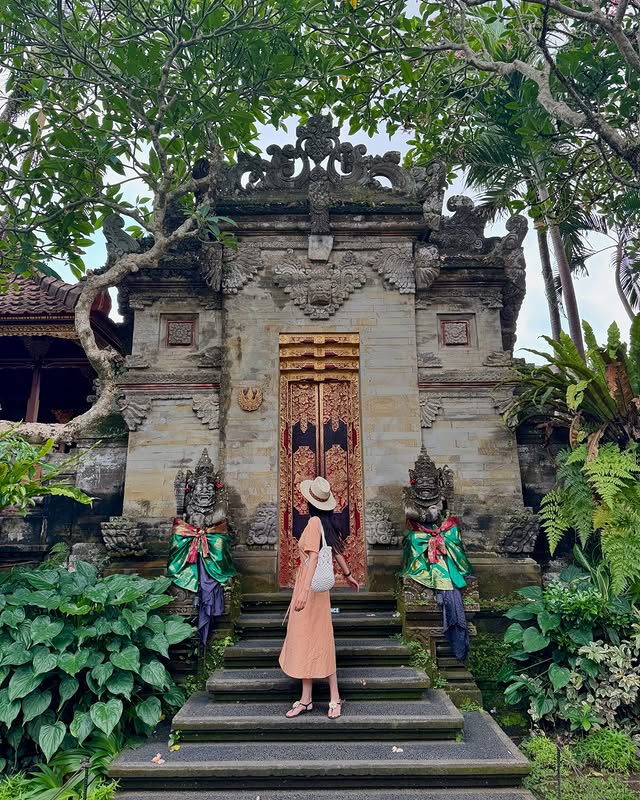
There’s an interesting fact about this royal palace, which is connected to Indian and Balinese mythology, and the story goes like this-👇🏻
| The Legend of Rsi Markandya-
According to legend, Rsi Markandya, a holy man from Eastern India, was divinely inspired to create a series of temples⛪ in the scenic Campuhan area of Ubud, a place infused with spiritual significance. He is said to have received a revelation to bury five precious metals in the mountain⛰️ slopes of Bali, implanting the land with sacred energy. ✨ It is also believed that it is Rsi Markandya who taught the irrigation system for the terraced landscape, which is still practised by farmers today. Campuhan is also home to the royal palace, a symbol of the island’s rich cultural heritage. Thus, it is believed that this palace holds some energy.✨ |
Puri Saren Agung serves as a cultural centre where traditional dance performances👯♀️, such as Legong and Barong, are held every evening. These dances bring ancient stories of Gods, demons, and heroes to life through intricate movements and vibrant costumes✨.
The dance performance details are given below-
| Day | Timing | Dance Performance | Ticket Price |
| Sunday | 7:30 PM | Legong Mahabharata | 100 IDR (₹600) |
| Monday | 7:30 PM | Legong Dance |
100 IDR (₹600) |
| Tuesday | 7:30 PM | Ramayana Ballet | 100 IDR (₹600) |
| Wednesday | 7:30 PM | Legong & Barong |
100 IDR (₹600) |
| Thursday | 7:30 PM | Legong Trance | 100 IDR (₹600) |
| Friday | 7:30 PM | Barong |
100 IDR (₹600) |
| Saturday | 7:30 PM | Legong Dance |
100 IDR (₹600) |
The palace also hosts significant ceremonies and rituals, including royal weddings👰🏻🤵🏻 and sacred temple events. These gatherings allow visitors to engage with Bali’s spiritual essence, fostering a deeper appreciation for the island’s rich and vibrant traditions.
- Location: Jl. Raya Ubud No.8, Ubud, Kecamatan Ubud, Kabupaten Gianyar, Bali 80571, Indonesia
- Timings: 7 AM- 6 PM
- Entrance Fee: Free
- Car Parking: 10,000 IDR (approx. 55 INR)
Do a Refreshing Hike amid the Rice Terrain
Banjar Mancingan Rice Terraces
The Banjar Mancingan Rice Trekking🌾 experience does not have a formal entrance fee, but it is suggested to donate 20,000 IDR. This donation helps keep the beautiful area well-maintained for future visitors.
A group of local residents works hard to keep the trails in good shape and accessible. This not only preserves the area’s beauty but also supports the community. As you walk🚶🏻♀️➡️ along the paths, the calming surroundings embrace you. Green plants🌱 surround you, and soft breezes flow through the rice fields, creating a peaceful atmosphere.

Each step on the smooth walkways refreshes you, providing a break from daily life. Take a deep breath, fill your lungs with fresh air, and let your mind relax in this quiet place.
Campuhan Ridge
The Campuhan Ridge Walk is a most loved natural trail and is considered a must-do thing in Bali due to its spectacular setting. The Campuhan Ridge Walk is located in Ubud, Central Bali. It starts near the Pura Gunung Lebah Temple and follows a fully paved path along the ridge line.
Close your eyes and imagine yourself in Campuhan Ridge as I give you the descriptive image- you walking on the stone-paved path, which winds through local rice fields alongside palm trees and tropical plants. Tall grasses sway softly in the breeze as if they are giggling, imparting a calm and serene beauty to the scenery.

After a short walk, the pathway curves gently, calling hikers to discover what lies beyond the horizon, adding an element of adventure to the journey. The surrounding rolling hills form a natural colosseum, amplifying the tranquillity of the view.
As the sun rises and shines through the morning mist, it brightens the landscape with a warm light that shows off the bright greens. The mix of light and shadow creates a dreamy feel, perfect for nature lovers and photographers. This beautiful place, likely in a tropical or subtropical area, offers a calm atmosphere, making it a great spot for a refreshing hike and a chance to enjoy nature’s beauty.
Nature lovers appreciate the opportunity to explore Campuhan Ridge Walk for its greenery and wildlife🐘, including various birds and animals. Photographers📸 particularly enjoy visiting during the Golden Hour, as it offers some of Ubud’s most spectacular photo opportunities.
Seek Blessings in Temples
Things to remember before entering temples in Bali,
Balinese temples⛪ have a unique and respectful dress code that visitors must adhere to in order to enter. This includes wearing a sarong that is tied securely around the waist. Without this attire, entry to the temple may be denied.
Visitors can conveniently rent a beautiful sarong from the temple’s security post for a modest fee of IDR 20,000 (approx. 110 INR). These sarongs are often vibrantly patterned, reflecting the rich cultural heritage of Bali and help ensure that everyone respects the sacred atmosphere of the temple.
Pura Dalem Agung Padangtegal
Pura Dalem Agung Padangtegal is a Hindu temple found in the southwestern area of the Sacred Monkey Forest complex. It is often called the Temple of Death and is dedicated to the Hindu God Shiva, known as Hyang Widhi.
Entry to this temple is free, but you need to pay an entry fee to visit the Sacred Monkey Forest Sanctuary. This temple features many decorations of Balinese demonic women who have bulging eyes, long tongues, sharp fangs, and sagging breasts that hang down to their stomachs. These figures create a spooky feeling.
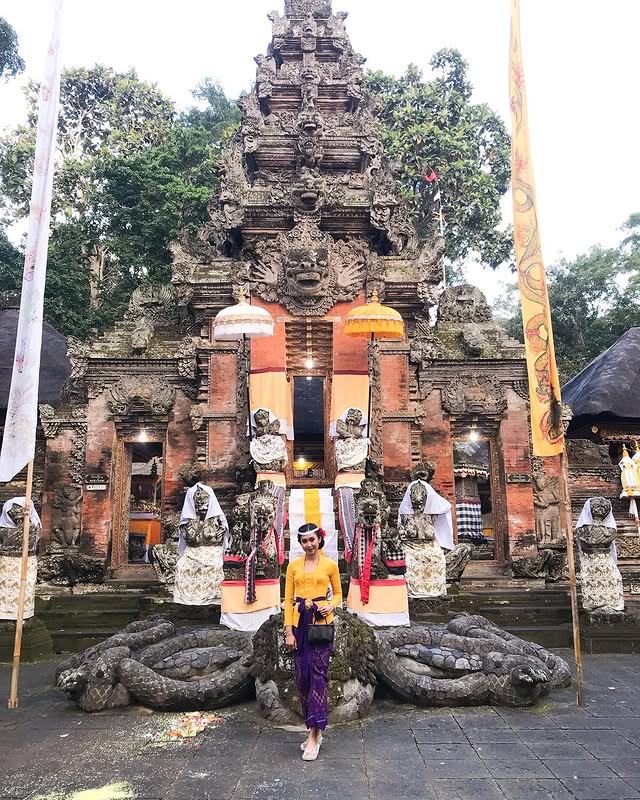
In Balinese stories, demons are linked to the underworld, known locally as ‘bhur’. This connection is one reason why the temple is named Pura Dalem Agung Padangtegal. This temple has a large open courtyard primarily used for the traditional Kecak Fire and Trance dance performances.
Also, there is a music pavilion popularly referred to as gamelans. The ensemble includes musical instruments that look like xylophones. They are made of wood and bronze, and each one is carved with detailed creatures from Balinese mythology.
The ground of the temple complex follows a striped pattern with alternating bands of grass and stone. It is believed to depict the balance of the two dichotomies of evil and good, something which is prevalent in the Balinese religion.
Also, this temple hosts the Kecak Fire Dance, commonly known as the classical “monkey chant” dance. Performances take place every Wednesday and Saturday at 7:30 PM in the temple complex’s courtyard.
- Monkey Forest Sanctuary: IDR 50,000 (approx. 270 INR)
- Kecak Dance Performance Timing: 7:30 PM (Wednesday and Saturday)
Goa Gajah
The term “Go Gajah” translates to “Elephant Cave,” which is a temple located in Bali. This complex features both Hindu and Buddhist imagery. Inside the cave, you will find lingam and yoni, symbols associated with Shiva, as well as an image of Ganesha.
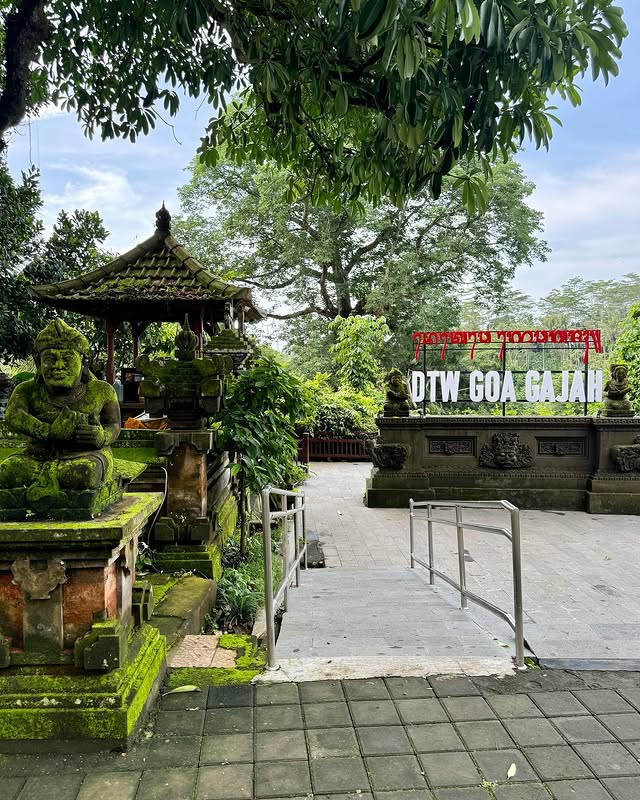
Along the riverbank, there are carved representations of stupas and chattra, which are significant in Buddhism. Additionally, the complex includes seven statues of women, although one has been destroyed due to an earthquake.
These women hold water pitchers that symbolise the seven holy rivers of India: the Ganga River, Sarasvati River, Yamuna River, Godavari River, Sindhu River, Kaveri River, and Narmada River.
The temple is distinguished by menacing faces carved into the stone, which are believed to ward off evil spirits. The main figure was once thought to be an elephant, which is how it earned the nickname “Elephant Cave.” To enter the cave, visitors must walk down a long flight of stairs.
As you walk up to the entrance, you’ll notice the beautiful carvings on the rock, with a large and detailed face watching over the cave’s opening. Once you step inside the temple, you’ll enter a calm courtyard filled with ancient items related to Hinduism and Buddhism.
The space is enhanced by lovely rock carvings, peaceful fountains that trickle softly, and quiet bathing pools that reflect the light, all contributing to the temple’s charm and rich history.
- Location: Bedulu, Blahbatuh, Gianyar Regency, Bali, Indonesia
- Timing: 8 AM- 6 PM
- Entrance Fee: 50,000 IDR (approx. 270 INR)
Pura Taman Saraswati
Pura Taman Saraswati, also known as Pura Taman Kemuda Saraswati and commonly referred to as the “Ubud Water Palace.” It is a startling architectural marvel located in the heart of Ubud, Bali.
This serene temple complex is particularly famous for its picturesque pool filled with vibrant pink lotus flowers, which bloom beautifully against the backdrop of the temple’s intricate carvings and green surroundings.
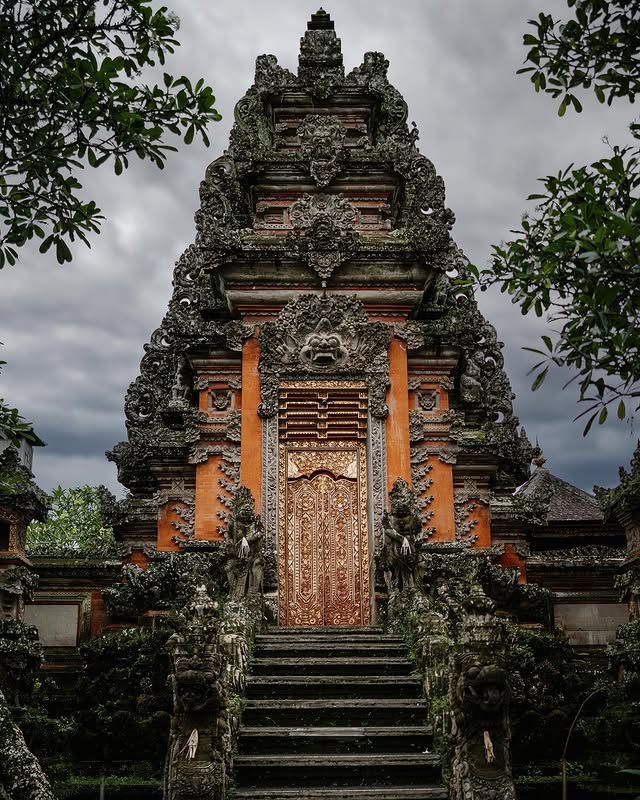
As you approach the temple, you will notice a place of worship known as Padmasana, situated on the northeast side of the area. This sacred space holds significant spiritual importance for the local community.
At the base of the Padmasana building, there is an impressive turtle-shaped sculpture that is artfully entwined with two dragons. This striking sculpture symbolises the balance of strength and wisdom in Balinese culture, adding to the temple’s rich artistic heritage.
Visitors to Pura Taman Saraswati are often captivated not only by the beauty of the lotus pool but also by the peaceful atmosphere, making it a perfect spot for reflection and appreciation of Balinese artistry and spirituality.
The temple hosts an array of traditional Balinese dance shows, with different forms of dance presented each evening, allowing visitors to immerse themselves in the rich cultural heritage of Bali. Notably, these performances take place every day of the week except for Fridays, providing a consistent opportunity for both locals and tourists to engage with the vibrant art form.
One of the highlights of the performances is the Kecak dance, which is skillfully performed by the renowned Sandhi Suara dance group.
Their dynamic interpretation of this traditional dance not only showcases the intricate movements and storytelling elements but also resonates with the spiritual essence of Balinese culture, making it a must-see for anyone visiting Ubud.
| Day | Timing | Dance Performance | Ticket Price |
| Sunday | 7:30 PM | Janger |
100K IDR (₹600) |
| Monday | 7:30 PM | Joged | 100K IDR (₹600) |
| Tuesday | 7:30 PM | Kecak Dance |
100K IDR (₹600) |
| Wednesday | 7:30 PM | Ramayana Ballet | 100K IDR (₹600) |
| Thursday | 7:30 PM | Kecak Dance |
100K IDR (₹600) |
| Friday | — | — | — |
| Saturday | 7:30 PM | Legong Dance |
100K IDR (₹600) |
- Location: F7V6+JHX, Jl. Kajeng, Ubud, Kecamatan Ubud, Kabupaten Gianyar, Bali 80571, Indonesia
- Timing: 8 AM- 6 PM
- Entrance Fee: Free
Gunung Lebah Temple
The temple’s name, “Gunung,” means mountain or hill, while “Lebah” translates to bee. This name reflects its unique location in the Campuhan Ubud River valley, overlooking the confluence of two rivers: the Oos River and the Cerik River.

Pura Gunung Lebah is located in a peaceful area surrounded by bamboo trees, with the Campuhan River flowing gently below. The temple has three courtyards, each offering a glimpse into Balinese culture.
As you enter the first outer courtyard, you can appreciate the beautiful Balinese designs and see the tall Padmasana shrines standing proudly in the centre. The two inner courtyards are usually opened during special ceremonies, allowing visitors to enjoy their beauty and significance during these events.
The Gunung Lebah temple is a serene destination characterised by its impressive traditional Balinese Padmanasa atop its robust structure. Adorned with ornate carvings and vibrant statues, this temple serves as the starting point for the scenic Campuhan ridge walk.
Among its architectural highlights is a stunning six-tiered pagoda, adding to the temple’s majestic presence. Inside the complex, you will find the Bale Gong, or gamelan pavilion, which hosts the orchestra during ceremonies.
Dancers typically prepare for their performances in this space. A majestic Bale Kulkul tower, home to the temple’s wooden bell, stands prominently within the area. The main shrines of the complex showcase varying numbers of roof tiers.
- Location: Jl. Raya Ubud No.23, Sayan, Kec. Payangan, Kabupaten Gianyar, Bali 80571, Indonesia
- Timings: 8 AM to 5 PM
Pura Desa Ubud
Pura Desa Ubud complex is located next to the Ubud Royal Palace (Puri Saren Agung) and translates to “Temple of the Village.” It is dedicated to the Hindu God Wisnu, the preserver in Hindu mythology, which serves an important function in the spiritual practices of the Balinese people.

The temple is admired for its traditional Balinese architecture, featuring intricate carvings, statues, and beautifully landscaped gardens that provide a tranquil atmosphere. Additionally, Pura Desa hosts various ceremonies, including temple festivals, religious rituals, and community events that showcase the vibrant cultural heritage of Bali.
The temple complex is made up of several courtyards and pavilions, each serving specific religious and ceremonial purposes. Visitors to Pura Desa Ubud have the opportunity to explore the grounds, admire the architectural details, and, if permitted, observe or participate in religious rituals.
During festivals and religious celebrations, such as Galungan and Kuningan, Pura Desa Ubud becomes a vibrant hub of activity. Colourful processions, offerings, and traditional performances take place within its precincts, creating a lively atmosphere for all who visit.
- Location: Jl. Raya Ubud No.35, Ubud, Kecamatan Ubud, Kabupaten Gianyar, Bali 80571, Indonesia
- Timing: 24 Hours
Do Some Shopping from Ubud’s Popular Markets
Gianyar Night Market
The Gianyar Night Market, also referred to as ‘Pasar Senggol Gianyar’ or ‘Pasar Malam Gianyar,’ is situated in Gianyar town, approximately 30 minutes north of Ubud. This market offers visitors an authentic and vibrant atmosphere, showcasing a variety of Balinese street food, local culture, and handicrafts.
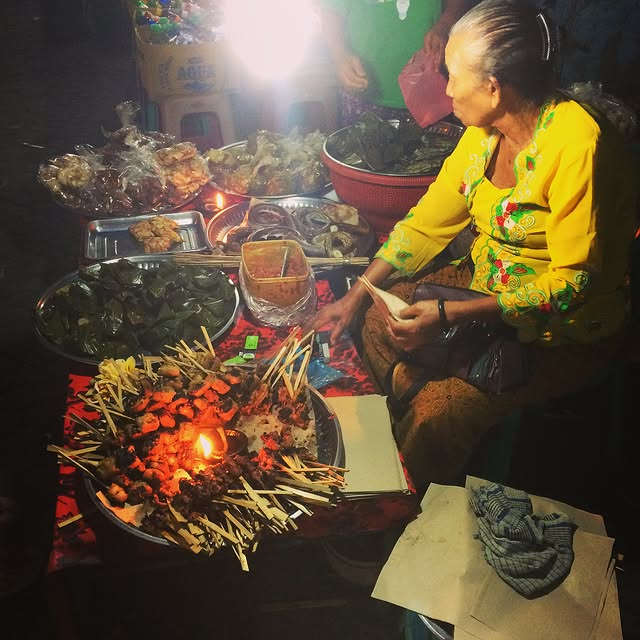
Walking through narrow lanes filled with food and clothing stalls lets you experience the local way of life. You can enjoy the colourful and lively atmosphere of the market.
Gianyar is a well-connected area in Bali, easily accessible by road from Ubud and other parts of the island, making it a convenient destination for tourists.
Visitors can explore a variety of Balinese handicrafts, including handwoven baskets and batik fabrics, as well as trendy clothing, fresh produce, and unique souvenirs.
Gianyar is particularly renowned for its extensive array of food stalls that offer traditional Balinese cuisine. Some must-try dishes include-
- Babi Guling (roast pork)
- Sate Lilit (minced meat satay)
- Nasi Campur (mixed rice)
- Ayam Betutu (slow-cooked chicken)
- Bakso (meatballs)
- Jajan Pasar (a sweet delicacy)
- Location: Jl. Ngurah Rai-Gianyar No.38, Gianyar, Kec. Gianyar, Kabupaten Gianyar, Bali 80361, Indonesia
- Timing: 3 PM-10 PM
Ubud Art Market
Ubud, often referred to as Bali’s art district, is a must-visit location when exploring the island. One of the highlights of Ubud is the Ubud Art Market, also known as Pasar Seni Ubud. This vibrant market offers a wide array of artistic and handcrafted Balinese goods, making it an ideal spot for tourists.
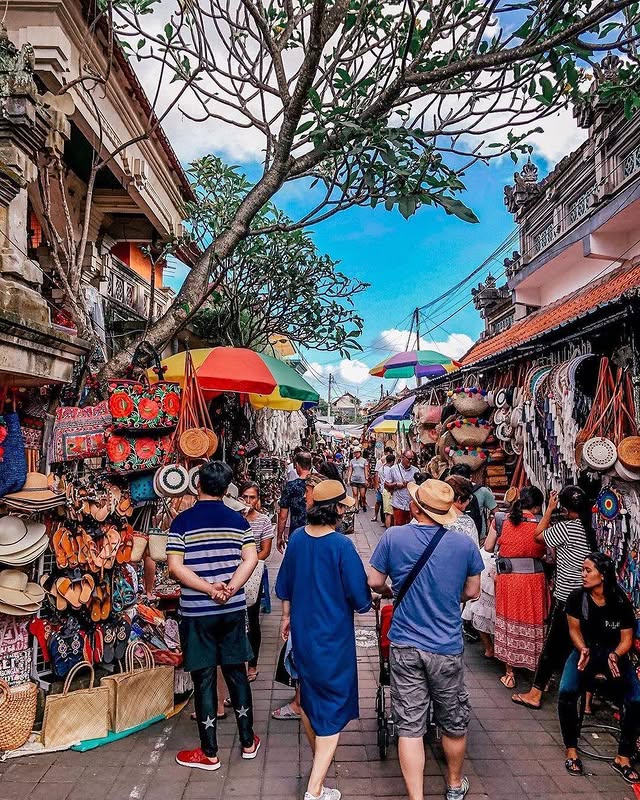
Visitors can find an assortment of items, including silk scarves, lightweight shirts, statues, kites, woven bags and baskets, hats, beach shorts, t-shirts, and various souvenirs that capture the essence of Balinese culture.
Traditional craftsmanship techniques play a vital role in creating authentic artisanal goods, offering a rich experience for tourists. The Ubud Art Market, situated in the heart of Ubud, Bali, is a vibrant and colourful marketplace that showcases Balinese culture and provides a variety of unique souvenirs.
Visitors can explore an array of stalls featuring handmade arts and crafts, including intricate wood carvings, traditional paintings, jewellery, woven baskets, clothing, and home decor. Many of these items are produced by local artisans, reflecting the island’s rich artistic heritage and craftsmanship.
The market features two distinct sections: one dedicated to arts and crafts and the other focused on clothing and souvenirs. This vibrant marketplace offers an engaging environment where visitors can negotiate prices while soaking in a friendly atmosphere.
The Ubud Art Market serves as a perfect destination for tourists seeking to acquire authentic pieces of Bali’s artistic heritage. It operates daily and is conveniently located near the Ubud Royal Palace, making it an easy stop after exploring the palace.
- Location: Jl. Raya Ubud No.35, Ubud, Kecamatan Ubud, Kabupaten Gianyar, Bali 80571, Indonesia
- Timing: 10 AM- 5 PM
Heal through Sound at The Pyramids of Chi
Enhance your spiritual journey in Ubud by participating in an ancient sound healing session at The Pyramids of Chi. Located just north of Ubud, these unique pyramids are constructed to scale with the Great Pyramid of Giza. It collectively creates one of the largest sound healing venues in the world.
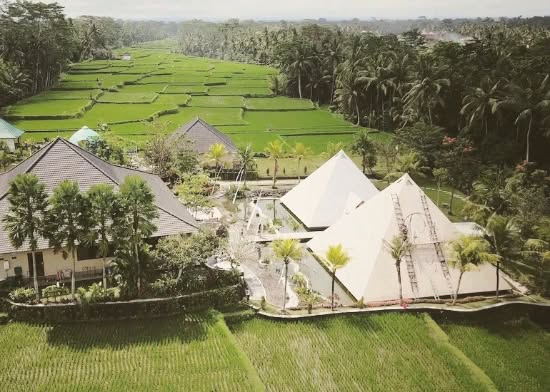
This setting offers a distinctive environment for experiencing the benefits of sound healing, allowing visitors to immerse themselves in a powerful and transformative practice. The centre integrates various elements, including Pyramid Power, Sacred Geometry, Polar Alignment, Ancient Sounds, and the unique energy of Bali.
In practical terms, participants will lie inside a pyramid structure while being enveloped by calming sounds from instruments such as singing bowls, gongs, drums, chimes, and flutes, which are designed to promote relaxation and tranquillity for both the mind and body.
The idea is that the vibrations and frequencies emitted by these sounds can help restore harmony within us. And the pyramid shape helps harness this.
In addition to ancient sound healing, the Pyramids of Chi also offers light therapy, cacao ceremonies, breath and voice workshops, spiritual awakening, full moon ceremonies, and much more.
- Location: Banjar Bentuyung Ubud, Jalan Kelebang Moding No.22, Tegallalang, Kec. Tegallalang, Kabupaten Gianyar, Bali 80571, Indonesia
- Timing: 8 AM- 9 PM
Get Insights on Bali’s Culture, Art and History Visiting Museums
Blanco Renaissance Museum
The Blanco Renaissance Museum showcases the life and work of Antonio Blanco, a Spanish-American painter who relocated to Bali in 1952. This museum is a testament to Blanco’s artistic journey.
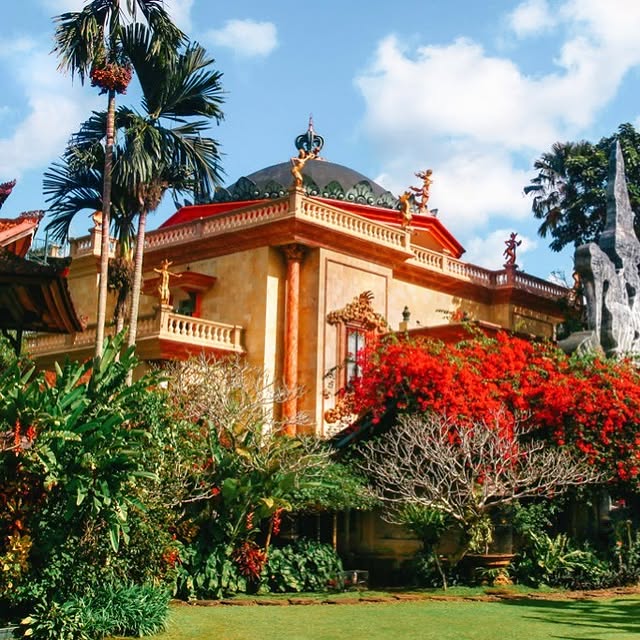
It was inspired by four key elements: the breathtaking scenery of Bali, a dreamlike atmosphere, the surrounding art culture, and his deep passion for creativity. The museum houses an extensive collection of over 300 of Blanco’s paintings, reflecting his unique style and contributions to the art world.
Antonio Blanco’s paintings predominantly showcase women, reflecting his admiration for the female form. His signature is prominently displayed 15 feet above the main entrance of the museum, serving as a striking focal point.
The museum has three floors and features four pillars that represent the painter’s four sons. Visitors can see some of his unfinished works on a sunken easel that is left untouched, giving a glimpse into his creative process. Overall, the museum reflects Balinese life and culture in a lively way.
- Location: Jl. Raya Campuhan, Sayan, Kecamatan Ubud, Kabupaten Gianyar, Bali 80571, Indonesia
- Timings: 9 AM- 5 PM
- Entrance Fee: 50,000 IDR (approx. 270 INR)
Puri Lukisan Museum
Balinese art is celebrated internationally for its unique beauty and cultural significance. The Puri Lukisan Museum is a prominent venue for this art form, featuring an impressive collection of traditional and modern Balinese paintings and wood carvings.
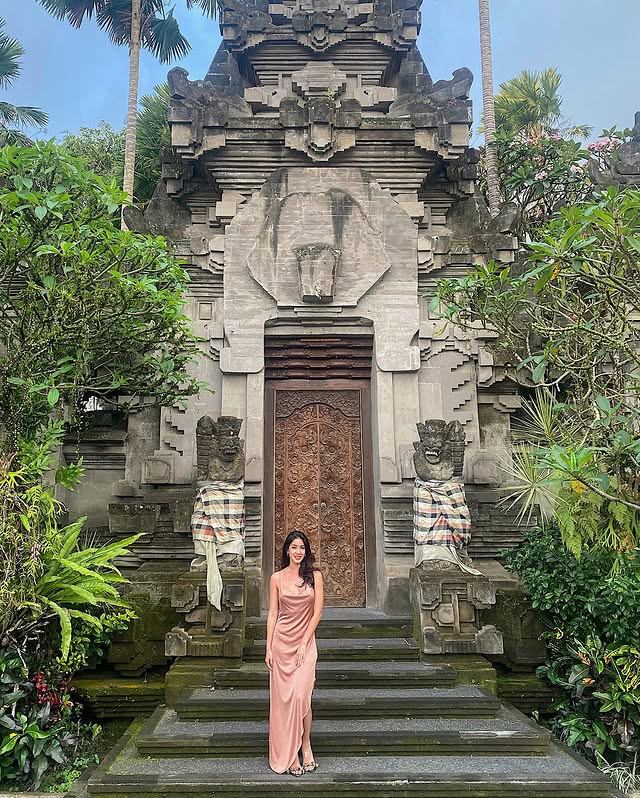
The museum is organised into four distinct buildings, each highlighting a different aspect of Balinese artistry:
- 1st Building: Pitamaha Gallery: This gallery showcases pre-war modern traditional Balinese paintings created between 1930 and 1945, along with an exquisite collection by I Gusti Nyoman Lempad, a notable Balinese artist.
- 2nd Building: This section is dedicated to the Ida Bagus Made Estate Collection, which includes remarkable wood sculptures and representations of Balinese dancers.
- 3rd Building: Here, visitors can explore the Wayang Painting Collection, which illustrates the traditional Indonesian shadow puppet performance art.
- 4th Building: This area highlights the museum’s history and is utilised for temporary exhibitions featuring new acquisitions and rotating displays.
Overall, the Puri Lukisan Museum offers visitors a comprehensive insight into the rich artistic heritage of Bali.
- Location: Ubud, Gianyar Regency, Bali 80571, Indonesia
- Timing: 9 AM- 5 PM
- Entrance Fee: 95,00 IDR (approx. 510 INR)
Neka Art Museum
The Neka Art Museum, established in 1982, is named in honour of Suteja Neka, a Balinese teacher who began collecting paintings to serve as a form of artistic documentation.
I Wayan Neka, the father of Suteja Neka, is known internationally as a carver. He is best recognised for making a three-meter-tall statue of the garuda bird. This statue was shown at the Indonesia Pavilion during the New York World Fair in the United States. The museum is now managed by Neka’s son, PM Kardi Suteja.
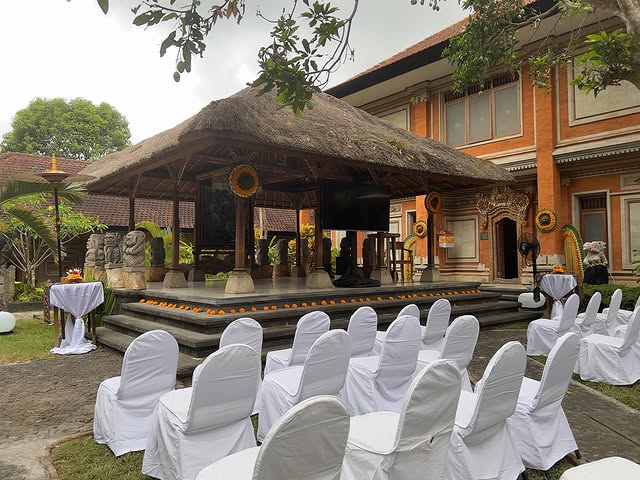
The museum features a design inspired by the traditional architecture of a Balinese compound, consisting of separate buildings, each serving a unique purpose. Visitors are invited to explore a sequence of galleries that begins with classical paintings and transitions to contemporary Indonesian art.
The journey continues with artworks created in Bali, as well as those influenced by the island’s rich culture, produced by foreign artists. In this museum, you can find the following artworks:
- Classical Puppet Style Painting
- Ubud Style Painting
- Arie Smit Pavilion: a collection of works by Dutch-born Indonesian painter Arie Smit
- Affandi Pavilion: showcasing Affandi’s Balinese paintings
- Lempad Pavilion: featuring collections by the Balinese maestro, I Gusti Nyoman Lempad
- Location: Jalan Raya Sanggingan Campuhan, Kedewatan, Kecamatan Ubud, Kabupaten Gianyar, Bali 80571, Indonesia
- Timing: 9 AM- 5 PM
- Entrance Fee: 150,000 IDR (approx. 800 INR), 75,000 IDR (approx. 400 INR)
Add a New Skill to Your Life’s Resume
Ubud Cooking Class
Taking a cooking class in Ubud is considered a great thing to do in Ubud, Bali for food lovers who take an interest in cooking as well as trying different cuisines. There are two types of classes that you can choose from- group class or private class.

Ubud Cooking Class includes-
- Market Tour: Most of the cooking classes in Ubud begin with a guided visit to a local market. This part of the experience introduces participants to the fresh ingredients commonly used in Balinese cuisine, including a variety of tropical fruits, herbs, spices, and vegetables. Attendees get the opportunity to learn about unique ingredients, such as tempeh, coconut milk, and various types of chilli peppers.
- Try Cooking: Following the market tour, you will go to the kitchen or cooking facility where the cooking occurs. Under the guidance of an instructor, the class will prepare several traditional dishes. Popular recipes often include nasi goreng (fried rice), ayam betutu (slow-cooked chicken), sate lilit (Balinese-style satay), and bebek betutu (slow-cooked duck).
- Cooking Techniques: Instructors generally share valuable tips on mastering traditional cooking techniques. Attendees will learn methods such as grinding spices with a mortar and pestle, crafting aromatic pastes, and using specific Balinese cooking tools.
- Cultural Experience: Beyond cooking, many classes provide insights into Balinese culture, explaining the significance of certain dishes within local ceremonies and daily life. Participants gain a deeper understanding of the role that food plays in Balinese rituals and traditions.
- Tasting the Dishes: Once the dishes are prepared, participants have the chance to sit down and enjoy the meal they have created. This aspect of the class allows individuals to savour the flavours in a relaxed and communal setting.
- Class Settings: Cooking classes may be conducted in family-run homes, offering an intimate and authentic experience. Alternatively, some classes take place in eco-friendly resorts or cooking schools that boast beautiful views of rice paddies or tropical gardens.
Batik or Fabric Painting
Batik is a time-honoured art form that dates back centuries, characterised by the meticulous application of wax onto fabric, followed by dyeing. This innovative process allows the wax to resist the dye, resulting in stunning patterns and intricate designs that vividly showcase creativity and craftsmanship.
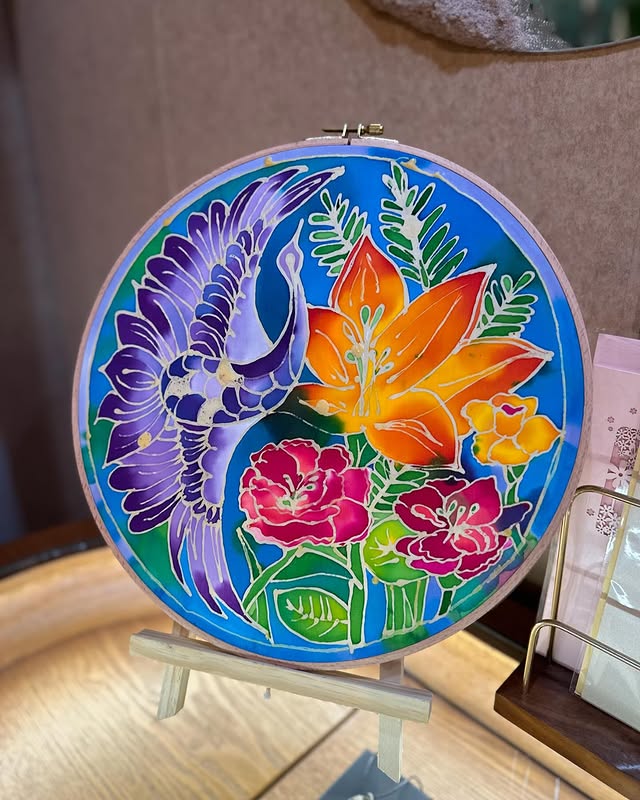
Enrolling in Batik classes in Ubud provides an excellent opportunity to immerse yourself in this traditional craft, where you can unleash your artistic potential and create a one-of-a-kind masterpiece.
As you learn traditional techniques passed down through generations, you will improve your skills and enjoy making personalised gifts for your loved ones. Each piece will reflect your creativity and love.
Jewellery Making Class
If you’re looking to try your hand at jewellery making in Ubud, there are a few places that offer fun and educational classes. Here are some recommendations:
Studio Perak (4.4 stars Google rating)
Known for its silversmithing classes, Studio Perak is a great place to learn how to make silver jewellery. Usually, people come to make customised souvenirs for gifting, and sometimes honeymoon couples too gift each other the silver ring that they make here.
This studio offers hands-on workshops where you can design and create your own pieces, from rings to necklaces. It’s an intimate setting, perfect for beginners or those with some experience.
Wayan’s Workshop
Wayan, a local jewellery artist, offers jewellery-making classes where you can learn to create beautiful pieces using various materials like silver, beads, and stones. His studio is relaxed, and he provides step-by-step instructions that cater to all skill levels.
Ubud Art Village (Ubud Art Market Area)
Some local artisans near the Ubud Art Market offer one-on-one or small-group jewellery-making workshops. You can usually find them by browsing the market or by asking around at local shops.
The Bali Jungle Jewellery Workshop
If you’re looking for something more unique and eco-conscious, you can check out jewellery-making classes that focus on using natural materials such as wood, bone, and shells. These workshops allow you to create intricate designs inspired by Balinese culture and nature.
Alam Ubud Jewellery Workshop
Alam Ubud Jewelry Workshop provides a hands-on experience for making silver jewellery at Alam Wayang Resort in Ubud. You can use up to 7 grams of silver to design your own piece. You will learn each step, from your initial idea to the final polishing.
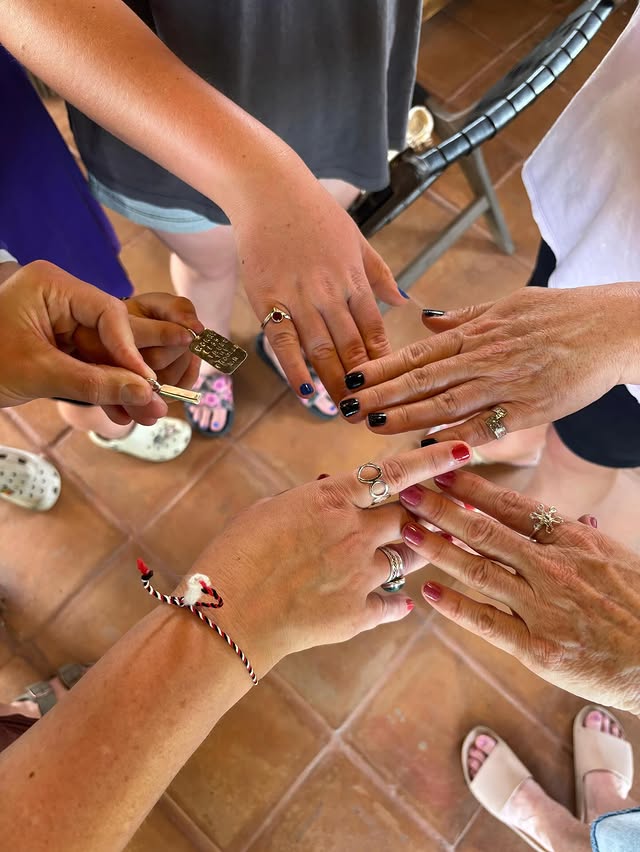
It’s always a good idea to reach out to the studio or workshop ahead of time to confirm availability and book your spot.
Wood Carving
If you are serious about learning wood carving, there are several schools in Bali that offer classes and workshops for all skill levels. These schools teach the fundamentals of wood carving using traditional Balinese methods, with a focus on creating intricate designs.
It’s an excellent opportunity for both beginners and those looking to enhance their skills. Located in Ubud, the workshop is run by local artisans who teach participants how to create a variety of designs, ranging from small decorative items to larger pieces, such as masks and figurines.
They will guide you step-by-step as you create your own wood carving, whether it’s a small statue, decorative item, or mask. It’s a good idea to book beforehand, as some workshops might fill up, especially during busy seasons.
Enjoy Exploring Sacred Monkey Forest
The Sacred Monkey Forest Sanctuary in Ubud is one of Bali’s most famous attractions. It is a 12.5-hectare forest that is home to over 700 long-tailed macaques.
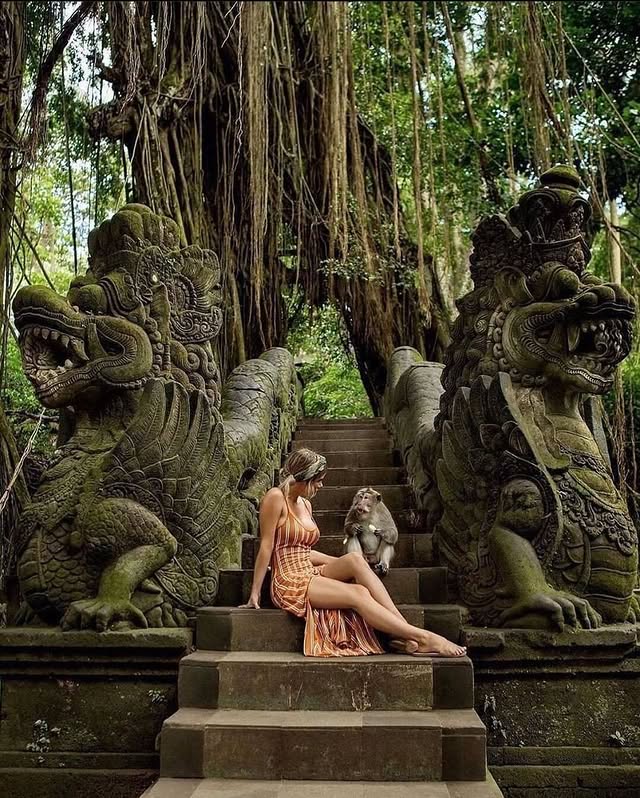
This sanctuary is not only a wildlife refuge but also holds cultural and spiritual significance, featuring three ancient temples dedicated to the Hindu Tri Hita Karana philosophy. Visitors can meander through the dense, vibrant jungle paths, surrounded by lush greenery and the sounds of nature.
As they cross beautiful stone bridges over clear streams, they might see playful monkeys swinging in the trees. These curious animals are comfortable to people, but it’s important to keep a safe distance. This helps them live well in their natural home, and it’s best not to feed them for their own good.
The sanctuary offers an excellent opportunity to explore the bond between nature and Balinese spirituality. The forest is home to several sacred temples, including Pura Dalem Agung, Pura Beji, and Pura Prajapati, which are frequently used for rituals and ceremonies.
This is a must-visit destination for nature lovers and anyone interested in experiencing the spiritual side of Ubud. Just be sure to keep your belongings secure, as the monkeys are known to be a bit mischievous with items like sunglasses and cameras.
- Location: Jl. Monkey Forest, Ubud, Kecamatan Ubud, Kabupaten Gianyar, Bali 80571, Indonesia
- Timings: 9 AM- 5 PM
- Entrance Fee:
- Weekdays (for adults)- 80,000 IDR (approx. 450 INR), (for children)- 60,000 IDR (approx. 320 INR)
- Weekends (for adults)- 100,000 IDR (approx. 550 INR), (for children)- 80,000 IDR (approx. 450 INR)
Take Part in Yoga Retreat and Wellness Centre
Ubud is Bali’s spiritual centre and the ideal place for yoga. Whether you’re a beginner or an experienced yogi, you’ll find many beautiful open-air shalas throughout the area. Also, there are many wellness centres and yoga retreats offering peaceful environments, expert instructors, and holistic treatments.
Taking part in a yoga retreat or visiting a wellness centre in Ubud can have numerous benefits for your physical, mental, and emotional well-being, such as
- Stress Relief & Relaxation
- Improved Flexibility & Strength
- Detoxification & Better Health
- Improved Mental Clarity & Focus
- Spiritual Growth & Inner Peace
- Increased Energy & Vitality
- Emotional Healing & Release
- Improved Sleep Quality
There is a list of a few yoga retreats and wellness centres for a relaxing holiday focused on health and well-being
- Yoga Barn
- Como Shambhala Estate
- Taksu Wellness Retreat
- Radiantly Alive
- Soulshine Bali
- Bali Spirit Festival
- Sumantra Resort & Wellness
- The Fivelements Retreat
Conclusion
Ubud is a must-visit destination in Bali, offering natural beauty, culture, and peace. If you want to explore the incredible rice terraces, visiting sacred temples, or indulging in local cuisine, Ubud provides an unforgettable experience.
When crafting your Bali itinerary, be sure to include Ubud for a serene escape while also discovering other popular places to visit in Bali, such as the beaches of Seminyak and the temples of Uluwatu.
Ubud’s charm and unique offerings make it a central part of any Bali adventure, ensuring a balanced and enriching holiday experience.
Frequently Asked Questions for Things to Do in Ubud, Bali
What are the top things to do in Ubud, Bali?
Some of the top things to do in Ubud include visiting the Sacred Monkey Forest Sanctuary, exploring the Tegalalang Rice Terraces, checking out the Ubud Palace, and shopping at the Ubud Art Market. You can also experience traditional Balinese dance performances and visit local art galleries.
What are the best things to do in Ubud, Bali?
The best things to do in Ubud are trekking through the lush rice terraces, indulging in a traditional Balinese spa experience, visiting Tirta Empul Temple for a purification ritual, and taking a cooking class to learn how to make authentic Balinese dishes.
What are some relaxing things to do in Ubud?
For a relaxing experience, you can visit a wellness centre for a yoga or meditation retreat, enjoy a luxurious spa day, take a leisurely stroll through the rice fields, or relax at the serene Campuhan Ridge Walk.
What are fun things to do in Ubud, Bali?
Some fun activities include visiting the Bali Swing for an adrenaline rush, taking a cycling tour around Ubud’s countryside, joining a traditional dance class, or visiting one of the vibrant art galleries in the area.
What are some free things to do in Ubud, Bali?
You can enjoy the beautiful Campuhan Ridge Walk, visit the Ubud Monkey Forest (with a small donation), explore the many temples around Ubud, or wander around the Ubud Palace and its surroundings.
Are there cheap things to do in Ubud?
Yes! You can explore the Ubud Art Market for affordable souvenirs, hike the Tegalalang Rice Terraces, visit local temples, or simply enjoy the beautiful surroundings without spending much.
What should I do in Ubud in one day?
In one day, visit the Sacred Monkey Forest Sanctuary, walk through the Tegalalang Rice Terraces, have lunch in a cafe overlooking the rice fields, and end your day by attending a traditional dance performance at the Ubud Palace.
What are some romantic things to do in Ubud?
For a romantic day in Ubud, take a private yoga class together, enjoy a couple’s spa treatment, dine at a candlelit restaurant with a view of the rice fields, or take a sunset walk along Campuhan Ridge.
What are the best spiritual things to do in Ubud?
To experience spirituality in Ubud, visit the Tirta Empul Temple for a holy water purification ritual, meditate at the Pura Gunung Lebah Temple, or take part in a yoga retreat at one of Ubud’s wellness centres.
What are offbeat things to do in Ubud?
Try visiting the hidden Tegenungan Waterfall, explore the Bali Bird Walks through the countryside, take a pottery class, or hike up to the top of Mount Batur for a sunrise trek.